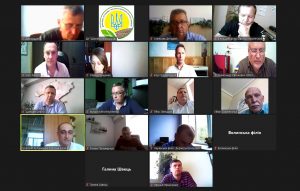Yesterday, July 28, a meeting of the Scientific and Technical Council of the SI “Derzhgruntokhorona” was held in the format of a video conference using the Zoom platform under the chairmanship of General Director Yuriy Zaytsev.
Among the issues on the agenda, the specifics of the selection and analysis of soil samples taken from disturbed lands as a result of military operations on the territory of Ukraine were discussed.
In particular, the so-called the director of the Sumy branch of State State Soil Protection State reported that to determine the impact of hostilities on the soil cover of Ukraine, soil samples were taken on agricultural lands of the Sumy and Okhtyr districts of the Sumy region. Three soil samples were taken from the places where air bombs fell, seven samples were taken from the places of broken equipment. Control (background) samples – from the territories that were nearby, with the exception of hostilities.
It was established that the content of gross forms of heavy metals in disturbed soil samples exceeds the background values by 1.1 to 15.5 times. The largest excess is due to the content of lead, the smallest is due to the content of iron.
Exceeding the maximum allowable concentrations for manganese content – in two samples (from 2.3 to 2.4 times); zinc was noted in all 10 soil samples (from 1.8 to 51 times); lead – in 6 samples (from 1.5 to 11.6 times). As for the iron content, it is not regulated (there is no MPC).
Exceeding the maximum permissible concentrations for cadmium content – in 7 samples (from 1.1 to 3.5 times); copper – in 5 samples (from 2 to 11.1 times). The nickel content in no sample exceeded the maximum allowable concentrations.
They also determined the content of oil and oil products, which are dangerous pollutants – especially for soil cover. It is believed that weak pollution can be eliminated in the process of self-cleaning of the soil in 2-3 years, average – in 4-5 years. As a result of the conducted research, a critical excess of the maximum permissible concentration was established in four out of ten soil samples. Compared to the background values, the content of oil products in all studied samples increased from 1.4 to 364 times.
As for the values of agrochemical indicators, they are mostly lower on disturbed soils, which is a consequence of disturbance and overturning of genetic horizons. The exception is the content of organic matter, which is explained by the processes of combustion and the formation of soot. The combustion process also explains the decrease in nitrogen content and the increase in potassium content.
The impact of military operations on ecological and agrochemical indicators on agricultural lands requires further study, but the impact is undoubtedly present.









